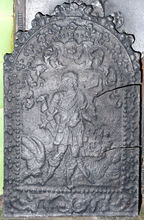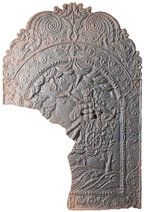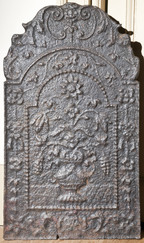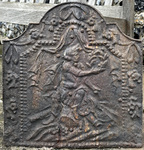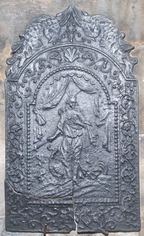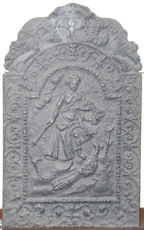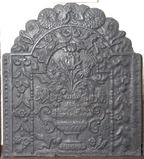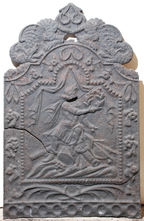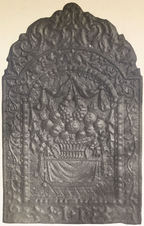-
328
Description: Arched rectangular central panel with bead edging; pictorial scene of a figure in Roman dress, holding a large sword, and holding the head of a bearded man in his left hand; below to the left, a naked, decapitated body; above the winged face of a putto between mirrored, scrolled foliage; arched rectangular border with fillet edging; flowers in chain under the arch and down the sides; at the bottom, swirled foliage; on top, a crown between fruit triads.
Notes: Perseus holding the severed head of the Medusa; possibly adapted from a drawing by Crispijn de Passe the elder (1564-1637). Similarities in the design and execution of the pattern suggest a common source with contemporary English firebacks.
- Decoration tags:
- 'Dutch' (shape)
- fillet (edging)
- whole carved pattern
- pictorial
- mythological
- humans
Manufactured: in the early 18th century in England.
Current location: Horsham Museum, Causeway, Horsham, West Sussex, England.
(part of the Horsham Museum museum group)
- Attached to series:
- British 'Dutch' style firebacks
-
325
Description: Arched rectangular shaped central panel with bead-and-pellet edging on a broad fillet; Jupiter in his chariot drawn by eagles; above are clouds, below is a landscape; arched rectangular shaped border with fillet edging, with a symmetrical scrolled wire design; the monogram, SHR, bottom centre; above is a symmetrical design of scrolled floral tendrils.
Notes: The design is probably adapted from a personification of the planet, Jupiter, in 'Planetarum effectus et eorum in signis zodiaci', by Marten de Vos (1585).
Inscription: SHR
- Decoration tags:
- 'Dutch' (shape)
- fillet (edging)
- whole carved pattern
- pictorial
- mythological
- allegorical
- text
- humans
Manufactured: in the late 17th to early 18th century in England.
Current location: Horsham Museum, Causeway, Horsham, West Sussex, England.
(part of the Horsham Museum museum group)
- Attached to series:
- SHR series
- British 'Dutch' style firebacks
- De Vos Planets series
-
341
Description: Arched rectangular shaped central panel with ’nutshell,’ paternost edging on a broad fillet; figure of Neptune/Poseidon holding a trident in his right hand, standing on a pedestal in the centre of a circular fountain, with two hippocampi, water issuing from their mouths; in front, a mermaid swims in waves, her arms raised; behind, blasts of wind issue from clouds; arched rectangular border with fillet edging; symmetrical design of seashells suspended from chains of pearls; bottom centre, the monogram between swirled plant tendrils; on top, symmetrical floral swirls.
Notes: Although very similar in size and design to a fireback in the 1724 series, this is not based on a design by Daniel Marot; instead it may have been inspired by the design for a fountain by Jean Lepautre (1618-82) published in a set of 12 etchings by Jean Le Blond in 1650. Almost certainly the 'iron chimney back' purchased by Henry Campion, of Danny, from John Legas for two guineas in 1731; another example, presumably from the same source, is at The Vine, near Basingstoke, Hampshire.
Copies of this fireback are known.
Inscription: SHR
- Decoration tags:
- 'Dutch' (shape)
- fillet (edging)
- whole carved pattern
- pictorial
- architectural
- text
- animals
- humans
- objects
Manufactured: in the early 18th century possibly at Gloucester Furnace, Lamberhurst in the Weald area of England.
Current location: Danny House, Hurstpierpoint, West Sussex, England.
Citation: Brent, C. & J., 2013, Danny House (Chichester, Phillimore), pp. 58-9.
- Attached to series:
- SHR series
- British 'Dutch' style firebacks
-
1117
Description: Arched rectangular shaped central panel, bead edging, narrow-necked urn with swagged decoration and gadrooned base, flowers issuing therefrom; arched rectangular shaped border with fillet edging and symmetrical floral festoons; on top, mirrored plant fronds descending from a small mask; at the bottom, an indistinct cartouche and a probable letter 'W' between swirled foliage.
Notes: Small firebacks of this type and period might have been cast at one of the London foundries and used for attaching to the rear of dog grates. The initial 'W' probably denotes the pattern maker.
Inscription: W
Manufactured: in the late 17th to early 18th century possibly in the London area of England.
Current location: in private hands, Isleworth, London, England.
- Attached to series:
- British 'Dutch' style firebacks
- W series
-
1253
Description: Central panel of arched rectangular shape with cavetto canted corners and bead edging; figure seated astride a triumph of weaponry (cannon, spears, drums), holding a laurel wreath in his right hand, surrounded by martial objects (flags, cannon, drums etc.), symmetrical hanging drapery above; same-shaped border with fillet edging and suspended ribbons with floral bunches
Notes: Possibly a depiction of an allegory of Victory. Other firebacks have the same distinctively shaped central panel and border shape, suggesting the same pattern maker. A reduced variant of a more elaborate fireback (no. 456) but missing mirrored serpents on top and probable reed decoration at the base.
- Decoration tags:
- cavetto-canted arched rectangular (shape)
- fillet (edging)
- whole carved pattern
- pictorial
- humans
- plants
Manufactured: in the late 17th to early 18th century possibly in the Weald area of England.
Current location: in private hands, Kingsdown, Kent, England.
- Attached to series:
- Mayfield 'Dutch' series
- British 'Dutch' style firebacks
-
358
Description: Arched rectangular central panel with bead edging on a broad fillet; standing on a ground with a peacock behind her, a classically-dressed figure of a female, wearing a crown and holding a sceptre in her right hand, her left hand across her chest; above her, swagged drapery; arched rectangular border with fillet edging; central scallop shell at the top with a descending arrangement of swirled and interlinked lines; at bottom centre, a cartouche bearing the letter ‘N’; on top, two mirrored serpents.
Notes: The figure is that of Hera/Juno. The pattern maker identified as ‘N’ is likely to have been working in collaboration with pattern makers whose fireback designs are identified with the initials, SHR and EB, and with the maker responsible for patterns made in 1724, some of which bore inscriptions in Welsh.
Inscription: N
- Decoration tags:
- 'Dutch' (shape)
- fillet (edging)
- whole carved pattern
- pictorial
- mythological
- text
- animals
- humans
Manufactured: in the early 18th century in England.
Current location: Baddesley Clinton Hall, Knowle, Warwickshire, England.
Museum number: 342886 (part of the National Trust museum group)
- Attached to series:
- N series
- British 'Dutch' style firebacks
-
415
Description: Arched rectangular central panel with bead-and-pellet edging on a broad fillet; figure of Hera/Juno, a sceptre in her right hand, with a peacock below to her left, clouds above left; arched rectangular border with fillet edging; symmetrical arrangement of wire-work swirls; on top, two mirrored serpents.
Notes: Similarities in the design and execution of the pattern suggest the work of the pattern-maker identified as ‘N’. Said to have been cast by Thomas Prickett (1727-95) at Gloucester Furnace, Lamberhurst.
Copies of this fireback are known.
- Decoration tags:
- 'Dutch' (shape)
- fillet (edging)
- whole carved pattern
- pictorial
- mythological
- animals
- humans
Manufactured: in the early 18th century probably at Gloucester Furnace, Lamberhurst in the Weald area of England.
Current location: Anne of Cleves House, Southover High Street, Lewes, East Sussex, England.
Museum number: LH000.948 (part of the Sussex Archaeological Society museum group)
Citation: Dawson, C., 1903, 'Sussex Iron Work and Pottery', Sussex Archaeological Collections, 46, pp. 1-54.
- Attached to series:
- British 'Dutch' style firebacks
-
425
Description: Arched rectangular central panel with bead-and-pellet edging; S-scroll, two-handled, gadrooned vase with tulip stems, flowers and leaves; arched rectangular border with fillet edging and suspended flower bunches; two symmetrical, coiled serpents on top; narrow, curved shouldered side panels with beads in oval depressions.
Notes: This is a shortened version of a much-copied fireback. Normally there is a bottom panel. Formerly part of the J. H. Every collection.
Copies of this fireback are known.
- Decoration tags:
- 'Dutch' (shape)
- fillet (edging)
- whole carved pattern
- extension panels
- plants
- objects
Manufactured: in the late 17th century in England.
Current location: Anne of Cleves House, Southover High Street, Lewes, East Sussex, England.
Museum number: 1944.24.091 (part of the Sussex Archaeological Society museum group)
- Attached to series:
- Flower Vase 'Dutch' types
- British 'Dutch' style firebacks
-
456
Description: Arched rectangular shaped central panel with canted, concave top corners and bead edging; figure seated astride a triumph of weaponry (cannon, spears, drums), holding a laurel wreath in his right hand, symmetrical hanging drapery above; same-shaped border with fillet edging and suspended ribbons with floral bunches; at base, symmetrical reeds tied with ribbon; base panel with nine linked rings; symmetrical serpents on top.
Notes: Possibly a depiction of an allegory of Victory. Other firebacks have the same distinctive central panel, border shape and decoration at the bottom, suggesting the same pattern maker. A reduced version (no. 1253) lacks the serpents on top and the reeds at the bottom. Formerly part of the J. H. Every collection.
- Decoration tags:
- 'Dutch' (shape)
- fillet (edging)
- whole carved pattern
- pictorial
- mythological
- humans
- objects
Manufactured: in the late 17th to early 18th century possibly in the Weald area of England.
Current location: Anne of Cleves House, Southover High Street, Lewes, East Sussex, England.
Museum number: 1944.24.079 (part of the Sussex Archaeological Society museum group)
- Attached to series:
- Mayfield 'Dutch' series
- British 'Dutch' style firebacks
-
1049
Description: Arched rectangular central panel with alternate two-bead and pellet edging; table with draped cloth surmounted by a basket containing fruit, swagged drapery above; arched rectangular border with fillet edging; descending vine with leaves and berries; bottom centre, initials separated by a lozenge; on top, symmetrical swirled foliage.
Notes: Typical pastiche of the 'Dutch' style of fireback produced with the option to affix it to a basket grate. Formerly part of the J. H. Every collection.
Inscription: I T
Manufactured: in the early 18th century in England.
Current location: Anne of Cleves House, Southover High Street, Lewes, East Sussex, England.
Museum number: 1944.24.082 (part of the Sussex Archaeological Society museum group)
- Attached to series:
- British 'Dutch' style firebacks
